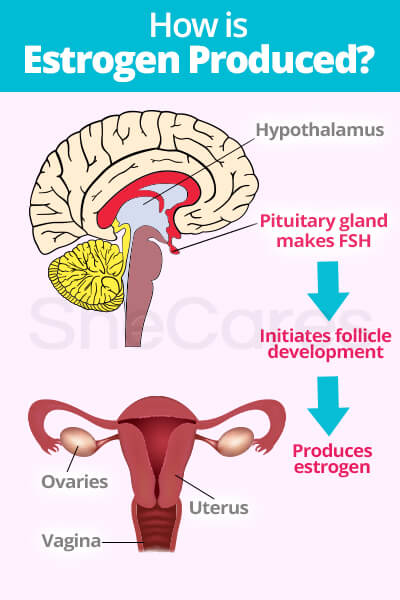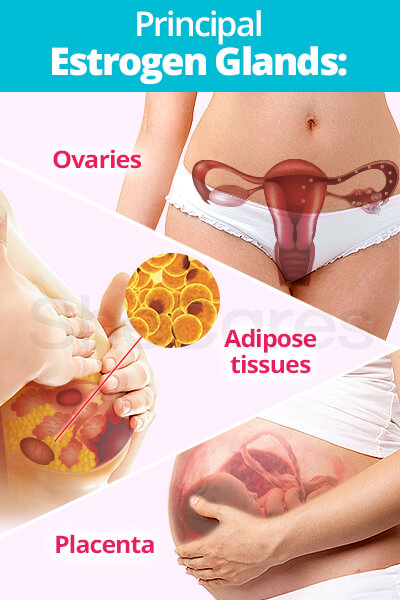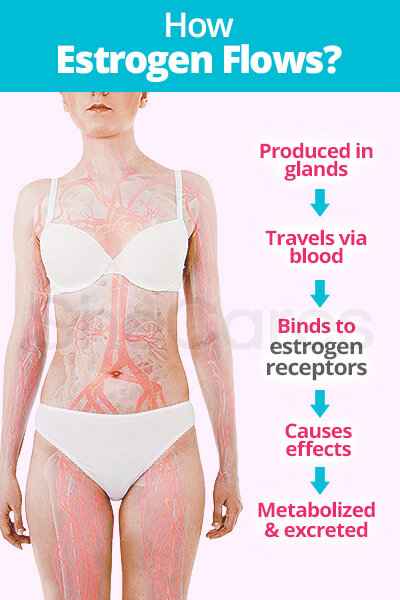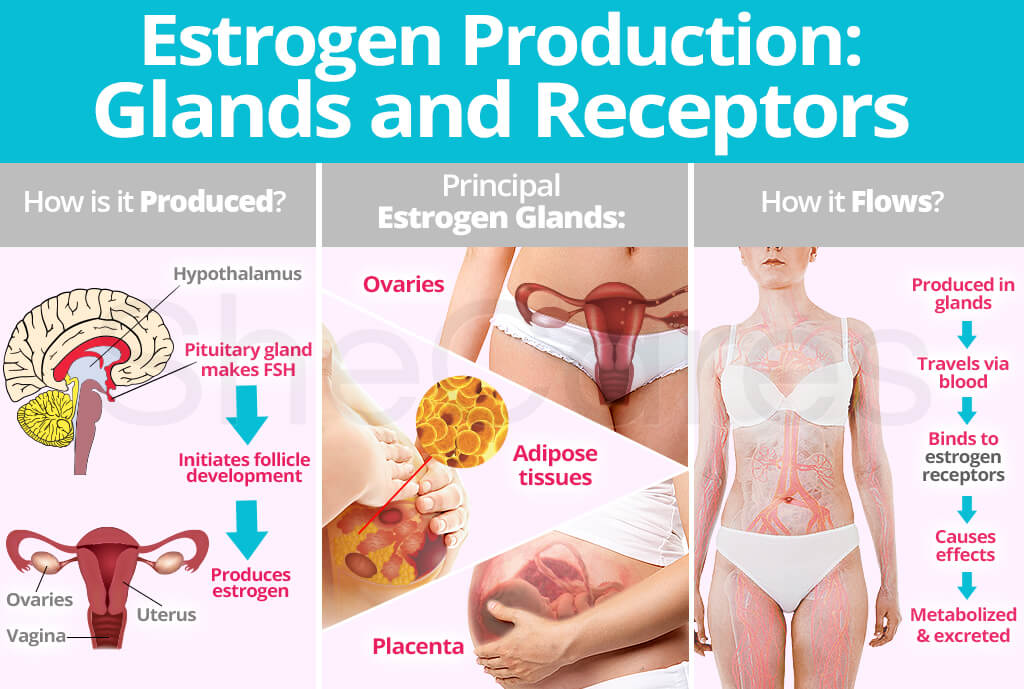Estrogen hormones promote the development and maintenance of female characteristics in the body. The quantity and type of estrogen hormone produced in a woman's body depends greatly upon the reproductive stage in which she finds herself.
Because there are a variety of bodily systems, glands, and receptors involved with estrogen production, this makes understanding estrogen's proper functioning all the more necessary. Read on to discover more.
Estrogen Production
Why is Estrogen Produced?
In essence, estrogen contributes to the well-functioning of a woman's body.
In regards to the menstrual cycle, estrogen is needed to make the lining of the uterus grow and thicken in preparation for a possible pregnancy, beginning on the first day of menstruation and ending with ovulation.
If conception occurs, estrogen is responsible for preparing the body for gestation and parturition, causing milk ducts in the breasts to widen and prepare for milk production, among other functions.
Where is Estrogen Produced?
The majority of the female body's estrogen - estradiol - is produced in the ovaries. It is formed within the corpus luteum and developing egg follicles. Smaller concentrations are produced by the breasts, liver, adrenal glands, and other non-endocrine tissues.
When ovarian function stops after menopause, small levels of estrogens are produced by converting adrenal precursors into estrone and estradiol.
Moreover, estriol - the predominant circulating estrogen during pregnancy - is produced in the placenta from estrogen precursors, which are made by the fetal adrenal gland and liver.
Furthermore, recent studies have proven the brain can produce and release estrogen, which may lead to a better understanding of the hormonal changes experienced before birth and throughout life.1
How is Estrogen Produced?
Ovarian estrogen is produced during the follicular phase of a woman's menstrual cycle, which begins on the first day of her period (cycle day one) and ends with ovulation. The first day of menses is when estrogen is at a low point.

At the start of each menstrual cycle, the hypothalamus prompts the pituitary gland to make follicle stimulating hormone, or FSH. FSH is responsible for initiating follicle development and subsequent estrogen production. As the follicle matures, the cells around the egg produce estrogen.
Once the follicle has produced sufficient estrogen, the elevated estrogen signals the pituitary gland to release luteinizing hormone (LH) to trigger ovulation - the release of the mature egg inside of the follicle - within a couple of days.
If the egg is not fertilized with conception, estrogen levels drop sharply until the beginning of the next cycle.
Estrogen Glands
Estrogen is synthesized in and secreted by a variety of glands for use locally and remotely within other areas of the body. The hormone is mainly produced by the ovaries, adipose tissues, and placenta. However, there are several minor production sites as well.
Ovaries

During the follicular phase of the menstrual cycle, cells around the developing egg in the ovaries will produce and secrete estrogen. This is the most common type of estrogen in women of reproductive age. This estrogen will be used to initiate ovulation of the mature egg and be used in further reproductive functions.
Adipose tissues
Adipose tissues - or body fat - produce and secrete estrone, the most common estrogen in women who are in postmenopause. Estrone is also formed from estradiol in organs, such as the liver, but adipose tissue is its major tissue site of conversion. In body fat, androgen precursors are converted to estrogen with the help of certain enzymes
Placenta
In pregnant women, the placenta produces and secretes the majority of estriol. This estrogen originates from androgenic precursors in the fetal liver, which is processed by the placenta. Due to the membrane that develops between mother and developing fetus, more than 90% of estriol enters into maternal circulation.2
Estrogen Flow

Flow of Estrogen in the Body
Once produced and secreted, estrogen is transported throughout the body in the bloodstream, targeting cells. Estrogens vary in their range of targets, and they regulate function by binding to special hormone receptor sites.
Moreover, because estrogen circulates in the bloodstream and binds to estrogen receptors on targeted cells, its improper amounts affect not only a woman's breasts and uterus, but also the brain, bones, liver, heart, and other important organs.
Estrogen Receptors
In general, once estrogens find a target cell on an organ, they penetrate and enter the cell. Their entry will then produce a variety of responses in the cell according to the amount of estrogen received.
Moreover, estrogens - along with other reproductive hormones produced by the gonads - are part of feedback loops that regulate their release and control their various effects on the body.
Estrogen Excretion
Estrogens are converted to inactive compounds in the liver and then excreted through the bowels or in urine. If this process is not working properly, it can cause reabsorption of high estrogen levels back into the body. This, consequently, invokes a hormonal imbalance, bringing about a plethora of other symptoms.
Continue reading to learn more about estrogen's multiple, transcendent roles and effects throughout the body to be on the path to having a complete understanding of its influence in women.
Sources
- Conrad, C. (2005). A Woman's Guide to Natural Hormones. New York: Penguin Group. Available from Google Books.
- Jordan, V.C. (2002). Estrogens and Antiestrogens. Encyclopedia of Cancer (Second Edition), 2, 179-188. doi: https://doi.org/10.1016/B0-12-227555-1/00077-0
- Monash University. (October 2010). Testosterone and androgens in women. Retrieved July 3, 2017, from http://med.monash.edu.au/sphpm/womenshealth/docs/testosterone-and-androgens-in-women.pdf
- National Women's Health Resource Center, Inc. (2017). Estrogen. Retrieved July 5, 2017, from http://www.healthywomen.org/condition/estrogen
- Nelson, L.R. & Bulun, S.E. (2001). Estrogen production and action. Journal of the American Academy of Dermatology, 45(3 Suppl), S116-24. Retrieved July 5, 2017, from https://www.ncbi.nlm.nih.gov/pubmed/11511861
- Siiteri, P.K. (1987). Adipose tissue as a source of hormones. The American Journal of Clinical Nutrition, 45(1 Suppl), 277-82. Retrieved July 7, 2017, from https://www.ncbi.nlm.nih.gov/pubmed/3541569
- State Government of Victoria, Australia: Department of Health & Human Services. (n.d.). Menstrual cycle | Hormonal (endocrine) system. Retrieved July 7, 2017, from https://www.betterhealth.vic.gov.au/health/conditionsandtreatments/menstrual-cycle | https://www.betterhealth.vic.gov.au/health/conditionsandtreatments/hormonal-endocrine-system
- Suzuki, N. et al. (1995). A possible role of estrone produced in adipose tissues in modulating postmenopausal bone density. Maturitas, 22(1), 9-12. Retrieved July 7, 2017, from https://www.ncbi.nlm.nih.gov/pubmed/7666818
- Tulane University. (n.d.). Endocrine System: Types of Hormones. Retrieved July 5, 2017, from http://e.hormone.tulane.edu/learning/types-of-hormones.html
- UCSF Medical Center. (n.d.). The Menstrual Cycle. Retrieved July 7, 2017, from https://www.ucsfhealth.org/education/the_menstrual_cycle/
- University of Edinburgh Medical School. (2013). The synthesis of Androgen and Estrogen from cholesterol presented as a SBGN diagram. Retrieved July 3, 2017, from http://uir.ulster.ac.uk/27719/
- University of Rochester Medical Center. (2017). Estrogen's Effects on the Female Body. Retrieved July 5, 2017, from https://www.urmc.rochester.edu/encyclopedia/content.aspx?ContentTypeID=85&ContentID=P00559
- U.S. Department of Health and Human Services. (n.d.). Menstruation and the menstrual cycle. Retrieved July 7, 2017, from https://www.womenshealth.gov/a-z-topics/menstruation-and-menstrual-cycle
- Women in Balance Institute: National University of Natural Medicine. (n.d.). Hormones 101 | About Hormonal Imbalance. Retrieved July 3, 2017, from http://womeninbalance.org/about-hormone-imbalance/hormones-101/ | http://womeninbalance.org/about-hormone-imbalance/
Footnotes:
- Kenealy, B.P. et al. (2013). Neuroestradiol in the Hypothalamus Contributes to the Regulation of Gonadotropin Releasing Hormone Release. Journal of Neuroscience, 33(49), 19051-9. Retrieved July 7, 2017, from https://www.ncbi.nlm.nih.gov/pmc/articles/PMC3850033/
- PubChem: Open Chemistry Database. (n.d.). Estriol. Retrieved July 7, 2017, from https://pubchem.ncbi.nlm.nih.gov/compound/estriol#section=Top
